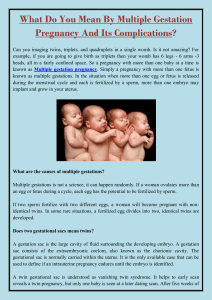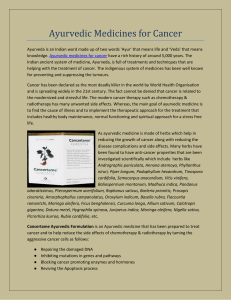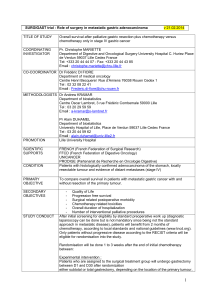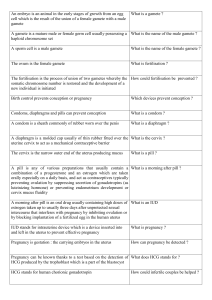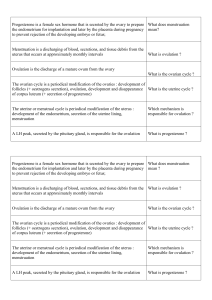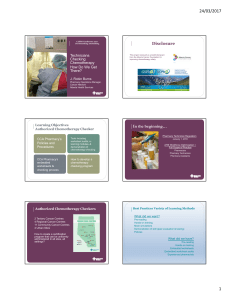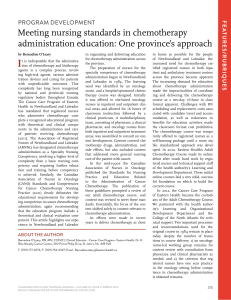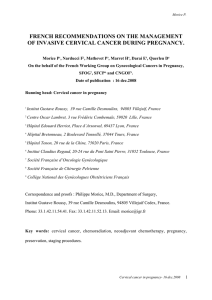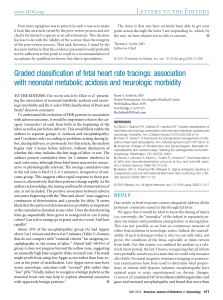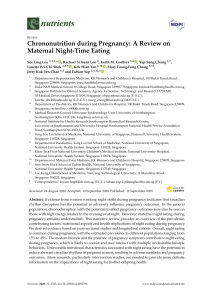000326562.pdf (40.25Kb)
publicité
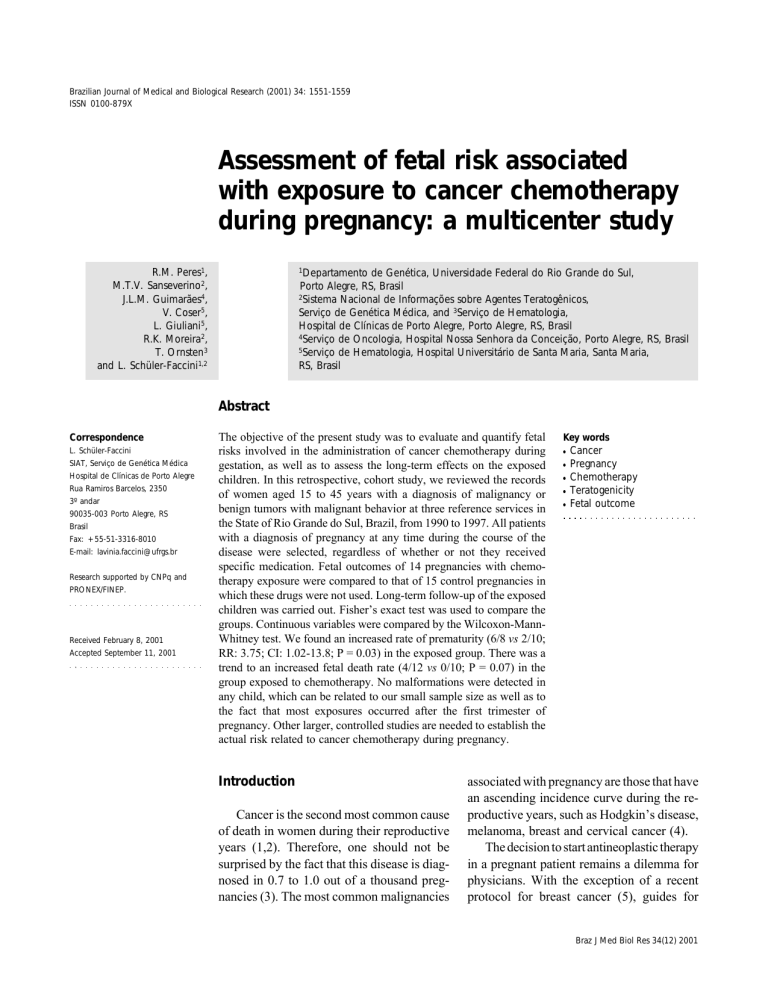
Brazilian Journal of Medical and Biological Research (2001) 34: 1551-1559 Cancer chemotherapy during pregnancy ISSN 0100-879X 1551 Assessment of fetal risk associated with exposure to cancer chemotherapy during pregnancy: a multicenter study R.M. Peres1, M.T.V. Sanseverino2, J.L.M. Guimarães4, V. Coser5, L. Giuliani5, R.K. Moreira2, T. Ornsten3 and L. Schüler-Faccini1,2 1Departamento de Genética, Universidade Federal do Rio Grande do Sul, Porto Alegre, RS, Brasil 2Sistema Nacional de Informações sobre Agentes Teratogênicos, Serviço de Genética Médica, and 3Serviço de Hematologia, Hospital de Clínicas de Porto Alegre, Porto Alegre, RS, Brasil 4Serviço de Oncologia, Hospital Nossa Senhora da Conceição, Porto Alegre, RS, Brasil 5Serviço de Hematologia, Hospital Universitário de Santa Maria, Santa Maria, RS, Brasil Abstract Correspondence L. Schüler-Faccini SIAT, Serviço de Genética Médica Hospital de Clínicas de Porto Alegre Rua Ramiros Barcelos, 2350 3º andar 90035-003 Porto Alegre, RS Brasil Fax: +55-51-3316-8010 E-mail: [email protected] Research supported by CNPq and PRONEX/FINEP. Received February 8, 2001 Accepted September 11, 2001 The objective of the present study was to evaluate and quantify fetal risks involved in the administration of cancer chemotherapy during gestation, as well as to assess the long-term effects on the exposed children. In this retrospective, cohort study, we reviewed the records of women aged 15 to 45 years with a diagnosis of malignancy or benign tumors with malignant behavior at three reference services in the State of Rio Grande do Sul, Brazil, from 1990 to 1997. All patients with a diagnosis of pregnancy at any time during the course of the disease were selected, regardless of whether or not they received specific medication. Fetal outcomes of 14 pregnancies with chemotherapy exposure were compared to that of 15 control pregnancies in which these drugs were not used. Long-term follow-up of the exposed children was carried out. Fisher’s exact test was used to compare the groups. Continuous variables were compared by the Wilcoxon-MannWhitney test. We found an increased rate of prematurity (6/8 vs 2/10; RR: 3.75; CI: 1.02-13.8; P = 0.03) in the exposed group. There was a trend to an increased fetal death rate (4/12 vs 0/10; P = 0.07) in the group exposed to chemotherapy. No malformations were detected in any child, which can be related to our small sample size as well as to the fact that most exposures occurred after the first trimester of pregnancy. Other larger, controlled studies are needed to establish the actual risk related to cancer chemotherapy during pregnancy. Introduction Cancer is the second most common cause of death in women during their reproductive years (1,2). Therefore, one should not be surprised by the fact that this disease is diagnosed in 0.7 to 1.0 out of a thousand pregnancies (3). The most common malignancies Key words · · · · · Cancer Pregnancy Chemotherapy Teratogenicity Fetal outcome associated with pregnancy are those that have an ascending incidence curve during the reproductive years, such as Hodgkin’s disease, melanoma, breast and cervical cancer (4). The decision to start antineoplastic therapy in a pregnant patient remains a dilemma for physicians. With the exception of a recent protocol for breast cancer (5), guides for Braz J Med Biol Res 34(12) 2001 1552 R.M. Peres et al. management of malignancies during pregnancy do not exist. It is universally recognized that a large number of malignant tumors, specifically breast cancer and hematological malignancies, cannot have their treatment delayed until the end of pregnancy. Due to the high rate of tumor cell proliferation, fetal well being may be compromised. A delay in treatment, in such cases, would certainly result in worsening of maternal prognosis (6,7). Likewise, the decision to terminate a pregnancy is complicated by ethical, moral and religious issues. Almost all cytotoxic agents are known to be teratogenic in animals, being associated with increased rates of malformations, fetal loss, intrauterine growth retardation, and other long-term effects on the progeny (8). In humans, however, the risk of teratogenesis related to this class of drugs has not been well established. The literature consists mostly of case reports, which tend to overestimate potential side effects of the pharmacologic substances being studied because of reporting bias (9,10). The few case series and cohort studies available are of limited value due to their small sample sizes and, for the most part, lack of control groups (5,1114). Due to limited data, quantifying the risk of fetal damage associated with exposure to this class of drugs becomes a complex task. The estimated risk for the exposed fetuses, according to these studies, varies from 7 to 75% for all major malformations (9). The lack of a precise risk estimation makes it difficult for physicians and patients to make clinical decisions. Here, we conducted a multicenter, collaborative study involving three oncology and hematology clinics in order to establish and quantify the risk associated with fetal exposure to antineoplastic agents. Material and Methods In this retrospective, cohort study, we reviewed the records of women aged 15 to Braz J Med Biol Res 34(12) 2001 45 years with a diagnosis of malignancy or benign tumors with malignant behavior at three reference services in the State of Rio Grande do Sul, Brazil: University Hospital of Porto Alegre, Oncology Service at Nossa Senhora da Conceição Hospital, and Hematology Service of the University Hospital of Santa Maria. We reviewed the records from December 1990 to December 1997. The Ethics Committees of all three hospitals evaluated and approved this study. We selected all patients with a diagnosis of pregnancy at any time during the course of the disease, regardless of whether or not they received specific medication. All the information about the disease, its evolution and therapeutics, such as histopathologic diagnosis, staging, date of diagnosis and period of gestation during which patients received specific medication was obtained by reviewing the medical records. We also recorded a detailed obstetric history including date of conception and obstetric or clinical complications. For pregnancies that resulted in liveborn children, data such as Apgar scores, anthropometry, neonatal complications and pediatricians’ assessment of possible congenital malformations were obtained from hospital records. We divided our sample into two groups: 1) those women who were exposed to chemotherapy during pregnancy, and 2) those who were not exposed to such treatment (including patients who underwent surgery or radiotherapy only and those who did not receive any treatment) but did have a diagnosis of malignancy concomitantly to the course of pregnancy and had not been submitted to cytotoxic treatment previously. In this study, chemotherapy exposure was defined as the use of cytotoxic agents (alkylants, antimetabolic agents, tumor antibiotics, alkaloids and miscellaneous agents). One case of exposure to bromocriptine (a noncytotoxic drug) was excluded, with 14 cases receiving cytotoxic drugs remaining in the exposed group. Pregnancy follow-up results were then compared 1553 Cancer chemotherapy during pregnancy between the two groups. Fisher’s exact test was used to compare the rates of stillbirths, abortion, prematurity, low Apgar scores, neonatal complications, and congenital malformations. Prematurity was defined as delivery occurring at a gestational age of less than 37 weeks. Continuous data such as maternal age, birth weight and gestational age at birth were compared by the WilcoxonMann-Whitney test, a nonparametric test for independent samples. Birth weight was adjusted for gestational age according to standardized charts (15). Long-term follow-up of the exposed children was carried out by assessment of childhood development milestones. Clinical history and physical examination data were collected by a dysmorphologist. The statistical analysis was performed with the SPSS 8.0 program for Windows. Results Of the patients with a diagnosis of a malignant tumor made at the referring centers, 860 were women of reproductive age. Of these, 29 (3.4%) were pregnant and were included in the present study. Fourteen of them received chemotherapy (exposed group) and 15 did not (non-exposed group). In our sample of pregnant women, the mean maternal age at the time of diagnosis was 29.6 ± 6.6 years, and the median age was 28.5 years (range: 18 to 43). The specific type of malignancy found in each group is presented in Table 1. The proportion of hematopoietic malignancies and solid tumors did not differ between the two groups. No significant difference in mean maternal age was observed between groups (P = 0.77). History of smoking or alcohol intake during gestation was negative for all patients. Regarding associated maternal diseases, only one case of systemic hypertension and one case of congestive heart disease secondary to the use of doxorubicin was observed in the exposed group. These find- ings, however, were not significant. A statistically significant increase in the rate of preterm births was observed in the exposed group. No case of major malformation was reported in either group (Table 2). Once adjusted for gestational age, no case of low birth weight was observed. In addition, the mean birth weight did not differ between groups. The specific chemotherapic drugs, as well as the gestational age of administration to the exposed group are presented in Tables 3 and 4. Table 1. Neoplasms found in the exposed and non-exposed groups. Neoplasm Breast HD CML ALL AML NHL Uterine cervix Lung Stomach Total Exposed group Non-exposed group N % N % 3 2 3 3 2 1 14 21 14 21 21 14 7 4 6 1 2 1 1 15 27 40 7 100 13 7 7 100 There was no difference in the proportion of hematopoietic/lymphoreticular and solid tumors between the two groups (P = 0.24, Fisher test). HD: Hodgkin’s disease; CML: chronic myeloid leukemia; ALL: acute lymphoblastic leukemia; AML: acute myeloblastic leukemia; NHL: non-Hodgkin’s lymphoma. Table 2. Comparison of fetal outcome between exposed and non-exposed patients. Fetal outcome Livebirths Preterm Major malformations Neonatal complications Apgar score <7 1' Spontaneous abortions Therapeutic abortions Stillbirths Exposed (N = 14) Non-exposed (N = 15) N % N % 8/12 6/8 0/8 3/8 2/8 1/13 1/13 4/12 67 75 0 38 25 8 8 33 10/10 2/10 0/10 1/10 1/10 0/10 5/15 0/10 100 20 0 10 10 0 33 0 RR 95% CI P value 0.67 3.75 3.75 2.50 ? 0.23 ? 0.45-1.0 1.02-13.8 0.48-29.52 0.27-22.86 ? 0.03-1.7 ? 0.07 0.03 0.20 0.41 0.60 0.12 0.07 Note: For comparison of the exposed and non-exposed groups, we excluded therapeutic abortions. In the non-exposed group, therapeutic abortions were performed very early, before 8-10 weeks and the products of conception were not examined. ? = Not possible to calculate due to zero value. Braz J Med Biol Res 34(12) 2001 1554 R.M. Peres et al. Table 3. Exposed group: outcome (livebirths) and chemotherapy employed. Case Neoplasm number (stage) Drugs Mother Trimester exposure (weeks) Baby Gestational age Birth weight (g) Neonatal complication Age at follow-up Abnormal development - - 1 HD Cisplatin + etoposide + cytarabine 2 (26) 36 2,540 Jaundice, non-hemolytic anemia 2 ALL Vincristine + idarubicin + L-asparaginase 2 (24; 28) 36 2,490 No 2 years No 3 CML Busulfan 2 (26-36) 36 2,600 No 11 years No 4 Breast (IV) Doxorubicin 3 (28) 31 2,070 RDS, BCP neonatal sepsis 6 years No 5 CML Hydroxyurea 2 (22) 39 3,800 No 4 years No 6 CML Hydroxyurea Vincristine + doxorubicin 1 (?) 2 (25) 35 3,195 Jaundice 4 months No 7* Breast (IV) 5-Fluorouracil + doxorubicin + cyclophosphamide 1 and 2 (2; 6; 10; 14; 18; 22; 26) 34 2,170 No - - 8 AML 2 (19) 39 3,000 No 9 years No Cytarabine + daunorubicin *The only case of preterm delivery due to worsening of maternal state. RDS: respiratory distress syndrome; BCP: bronchopneumonia; HD: Hodgkin’s disease; ALL: acute lymphoblastic leukemia; CML: chronic myeloid leukemia; AML: acute myeloblastic leukemia. Table 4. Exposed group: outcome (pregnancy losses) and chemotherapy employed. Case number Neoplasm Drugs Trimester of exposure (weeks) 9 ALL Vincristine + epirubicin + prednisone 2 (19) 10 AML Idarubicin + cytarabine 11 NHL (IV) Cisplatin + etoposide 2 (22) 12 Breast (IV) Cyclophosphamide + methotrexate + 5-fluorouracil 13 (spontaneous abortion) ALL 14 (elective abortion) HD Fetal death Necropsy time (weeks) 30 Result No - Yes IUGR, oligohydramnios; no malformation 26 Yes Fetal autolysis; no malformations 1 (5; 8) 25 Yes No malformations Vincristine + doxorubicin 1 (13) 17 No MOPP-ABVD 1 (3-7) 18 Yes - No malformations; toxic degenerative changes in liver and kidneys, placenta with villus degeneration and vascular toxic degeneration MOPP: mechloretamine + vincristine + prednisone + procarbazine; ABVD: doxorubicin + bleomycin + vinblastine + dacarbazine; IUGR: intrauterine growth retardation; ALL: acute lymphoblastic leukemia; AML: acute myeloblastic leukemia; NHL: non-Hodgkin’s lymphoma; HD: Hodgkin’s disease. Braz J Med Biol Res 34(12) 2001 1555 Cancer chemotherapy during pregnancy Due to the small numbers of patients on a particular regimen, we were not able to associate a specific chemotherapeutic scheme with a particular adverse outcome. We also tested the effect of monotherapy versus polytherapy on fetal outcome, but no difference was observed in our sample [RR (CI): 2.0 (0.33-12.18), P = 0.4 for stillbirths; RR (CI): 1.25 (0.52-3.0), P = 0.58 for preterm delivery]. In the exposed group, among liveborns, only two exposures occurred during the period of organogenesis. One premature birth was induced because of worsening of maternal disease and all others were due to obstetric complications. Long-term follow-up did not detect any abnormality in the development of the six liveborns examined. We lost two long-term follow-ups due to a change in address. The non-exposed group is characterized in Table 5. Two preterm deliveries occurred (cases 16 and 17) due to premature rupture of membranes. Therapeutic abortion was induced in five patients. Among these cases of therapeutic abortion, one patient was exposed to radiotherapy (mantle field), and another was submitted to surgery (radical modified mastectomy during the second trimester). Discussion Most cytotoxic agents exert their effect by interfering with some stage of DNA and RNA synthesis, by interrupting essential metabolic pathways, and by destroying macromolecules, not only of tumor tissue, but also of normal tissue. In the case of pregnancy, both maternal and fetal tissue may be affected, resulting in systemic toxicity and teratogenicity (16). Almost all chemotherapeutic and cytotoxic agents are known to be highly teratogenic to animals. When progeny is exposed to such substances during organogenesis, major malformations as well as an increased risk of miscarriage are observed. Exposure after organogenesis is associated with increased rates of prematurity, stillbirths, and intrauterine growth retardation (8). However, the doses used in animal experiments are much higher than those employed to treat humans. This, in addition to the fact that the entire process of teratogenesis varies from one species to another, makes extrapolation of animal data to humans a difficult task (17). Case reviews found in the medical literature indicate that administration of chemotherapy during the first trimester of pregnancy is associated with higher rates of abortion and malformations, and administration later in pregnancy is associated with a greater risk of prematurity, fetal death and intrauterine growth retardation (7,18-23). Table 6 presents case reviews published in the literature about exposure during pregnancy. In some case reviews, polychemotherapy was associated with a higher risk of congeniTable 5. Non-exposed pregnancies: outcome. Case Neoplasm (stage) Delivery (weeks) Livebirths 16 17 18 19 20 21 22 23 24 25 Breast Uterine cervix (IA) HD CML HD (?) HD (IV) HD (IV) Lung (IV) Breast (IV) Stomach (IV) 36 33 37 37 40 39 37 37 38 39 Therapeutic abortions 26 27 28 29 30 Breast (III) HD (IIB) Uterine cervix (IIA) HD (IA) NHL (?) 18 12 8 7 12 A marked difference exists in the characteristics of maternal disease between the liveborn group and the therapeutic abortion group. In the former, mothers had malignancies in advanced stages, in which early treatment and pregnancy interruption would not result in clinical benefits, whereas in the therapeutic abortion group, mothers had cancer at an early stage, in which pregnancy interruption and administration of aggressive therapy would be beneficial. HD: Hodgkin’s disease; CML: chronic myeloid leukemia; NHL: non-Hodgkin’s lymphoma. Braz J Med Biol Res 34(12) 2001 1556 R.M. Peres et al. tal malformations as compared to monochemotherapy (22-24). Cohort studies published in the literature involve sample sizes ranging from 9 to 43 gestations (Table 7). In only one of these studies, however, was a control group used to estimate the relative risk associated with fetal exposure to chemotherapeutic agents (14). This control group, however, was composed of healthy pregnant women, and, as such, could not identify potential risks due to maternal canTable 6. Pregnancy outcome for patients with cancer in pregnancy: literature review. Reference Nicholson (18) Catanzarite and Ferguson II (21) Doll et al. (22) Wiebe and Sipila (20) Ebert et al. (26) N 1st trimester exposure Preterm SA Stillbirth Birth LBW defects (%) 185 47 + + + + + + + + 7.5a - + + 139 121 217 + + + * + + * + + * + + 17a, 6b + 8.3a * + + SA: spontaneous abortion; LBW: low birth weight. *Not tested. +: presence of exposure during the 1st trimester; -: absence of exposure during the 1st trimester. apolychemotherapy; bmonochemotherapy. cer itself. Contrary to what case report reviews indicate, the rates of miscarriage observed in these cohort studies do not seem to be elevated, with the exception of the study by Zemlickis et al. (14). These findings, however, can be explained by the fact that, in our study, as well as in other cohort studies, not all exposures occurred during the first trimester of gestation. When only exposures that took place during the first trimester are considered, abortion rates of 20% (or 1/5) (our study), 25% (or 1/4) (12) and 44% (or 4/ 9) (14) have been reported. Therefore, we may conclude that exposure to chemotherapeutic agents during the first trimester of gestation is possibly associated with an increased risk of early fetal losses. A significantly higher rate of prematurity was observed in the exposed group in our study compared to the control group. The high rates of prematurity observed in the two other existing cohort studies, on the other hand, may be explained by frequent induction of birth due to the worsening of maternal disease (11,14). In our study, however, only one birth was induced for this reason, which implies that chemotherapy itself could Table 7. Pregnancy outcomes in cancer patients: cohort studies and the present study. Reference N Number of 1st exposures Livebirths SA SB§ Pizzuto et al. (11) 9 4 8 none 1/9 Mulvihill et al. (12) 32 4 23 2/25 Avilés et al. (13) 43 20 43 Zemlickis et al. (14)* 21 13 Berry et al. (5) 24 Present study** 14 SGA Preterm Birth defects Long-term follow-up exposed group Development 2/8 none yes Normal 2 months up to 15 years (6/9) 1/25 none none 5/23 no none none none none none yes 11 4/16 4/16 9/11 5/11 2/11 no - 1 24 none none 1/24 3/24 none no - 6 8 1/14 4/14 6/8 none yes 5/8 0/8 SA: spontaneous abortion; SB: stillbirth; SGA: small for gestational age. *Used a control group (healthy women) for assessment of potential fetal hazards. **Used a control group (patients with cancer and without treatment) for assessment of potential fetal hazards. §Denominator excludes therapeutic abortion. Braz J Med Biol Res 34(12) 2001 Normal 3 months up to 19 years (43/43) Normal 4 months up to 11 years (6/8) 1557 Cancer chemotherapy during pregnancy have a direct effect on prematurity rates. Most of our preterm babies were born at 36 weeks of pregnancy, which does not mean extreme prematurity. Even so, they are at higher risk of morbidity than full-term babies. There was a trend to an increased rate of stillbirths in our study, which, however, was not significant. This lack of significance could be explained by the small sample size. Elevated rates of stillbirths were also reported in three cohort studies (11,12,14) and in several case series studies (18,20,21,25), representing an important effect of chemotherapy. In our study, cytotoxic treatment was started earlier in women who had stillbirths compared to those women whose babies were born alive. This is related to the fact that more aggressive tumors need earlier treatment. We emphasize that our study, to our knowledge, is the first to use a control group of pregnant women with diagnosed malignancy who were not receiving chemotherapy of any kind. Although we used a group not exposed to chemotherapy as control, we observed more aggressive tumors in the exposed group compared to the non-exposed women. This could explain the higher incidence of stillbirths and preterm babies in the exposed women. Also, since there were more therapeutic abortions in the non-exposed group we cannot predict what the outcome would have been in these cases. Therefore, we cannot infer that the high rates of stillbirths as well as of prematurity reported in this study were only due to a direct effect of the cytotoxic therapy, and not also to complications secondary to maternal disease. As opposed to the majority of published reports such as cohort studies and reviews of case reports, which use birth weights lower than 2,500 g as an indicator of low birth weight, in our investigation weight was corrected for gestational age. This fact partially explains the absence of children classified as having low birth weight reported here. It should be noted, however, that Zemlickis et al. (14) also used this correction and found a significantly higher proportion of neonates who were small for gestational age. In addition, complications secondary to maternal disease may have had adverse effects on fetal intrauterine growth, representing an important bias in all studies which did not use a control group. Unfortunately, we cannot evaluate the real impact of chemotherapy on birth weight and its role in intrauterine growth restriction in the exposed group due to the increased number of stillbirths. The study of Avilés et al. (13) was the only one which differed significantly with regard to fetal outcome when compared to other studies, including ours. In their cohort of 43 women treated for hematological malignancies, the rates of prematurity, abortions and stillbirths were not different from those expected for the general population. This difference could be explained by the fact that only livebirths were included in this study. We did not observe any malformation among the six liveborn babies who were exposed to chemotherapy during gestation. Two explanations for this observation are possible: 1) with the exception of three cases who were exposed to cyclophosphamide, mechlorethamine, and methotrexate, which are known to have a teratogenic potential, the other drugs used have not been incriminated as definite teratogens in the literature (22,23); 2) the sample was too small to detect an increase in the rate of congenital malformations. Also, these children were exposed to a highly heterogeneous group of cytotoxic agents. Most of the published literature on this topic, however, also includes a variety of chemotherapeutic regimens. The long-term follow-up of the six children who were exposed to chemotherapy in utero is described in Table 7. We did not observe developmental abnormalities in this sample, which confirms the findings of the other two long-term studies about this subBraz J Med Biol Res 34(12) 2001 1558 R.M. Peres et al. ject. One of the possible long-term consequences of intrauterine chemotherapy is carcinogenicity. There is only one case report of a child born to a mother who used cyclophosphamide throughout pregnancy. She developed a papillary carcinoma of the thyroid at 11 years of age and a neuroblastoma at 14 years of age. She was also the only child exposed to chemotherapy during pregnancy reported to have mental retardation (25). However, in order to establish the actual long-term risk, especially that related to the development of carcinogenesis, a longer follow-up period than the one reported here would be necessary. In our study, no significant difference was observed when the fetal outcome of women who had hematopoietic malignancies was compared to that of women who had solid tumors. Although some authors suggest that hematopoietic malignancies during pregnancy might be associated with an increased number of complications due to the drugs employed to treat them as well as to their more aggressive behavior (11,21), this subject remains controversial. In fact, Ebert et al. (26) recently compared the rates of abortion, stillbirths, and fetal malformations among 217 literature cases, afflicted by several diseases, in which cytotoxic treatment was employed during pregnancy. According to this study, rheumatic diseases formed a group which was associated with the highest rates of adverse effects in pregnancy (37.5%), followed, in order of frequency, by miscellaneous diseases, gynecological malignancies, and finally by lymphomas and leukemias, which had the lowest complication rates. The results of our study indicate that cytotoxic agents could exert adverse effects when employed during gestation, causing an increased rate of prematurity and stillbirths. Due to the small sample size and to the fact that only six exposures occurred in the first trimester of gestation, the potential teratogenic effect of cytotoxic agents, when used during the organogenesis period, could not be assessed, although no case of congenital malformation was observed in our study. The normal development of the six children exposed in utero indicates a good prognosis for the liveborn children without malformations. The period of follow-up ranged from 4 months to 11 years after birth. The present data serve as additional evidence that a rigorous, multidisciplinary approach is needed for pregnant women with malignant neoplasms. Additionally, our study supports the need for a meta-analysis on this subject. Other cohort studies with larger sample sizes are necessary to elucidate the true risk associated with administration of antineoplastic agents during pregnancy. Acknowledgments We are grateful to Dr. Myla Moretti, Assistant Director of the Mother Risk Program, for technical support with the statistical analysis and for translating the manuscript into English. We also thank the Directors of the Ethics Committees of the Medical Services involved in this multicenter study for approval and collaboration. References 1. Wingo PA, Ries LA & Rosenberg HM (1998). Cancer incidence and mortality 1973-1995: a report card for the U.S. Cancer, 82: 1197-1207. 2. Landis SH, Murray T, Bolden S & Wingo PA (1999). Cancer statistics, 1999. CA: A Cancer Journal for Clinicians, 49: 9-64. Braz J Med Biol Res 34(12) 2001 3. Potter JF & Schoeneman M (1970). Metastasis of maternal cancer to the placenta and fetus. Cancer, 25: 380-388. 4. Donegan WL (1983). Cancer and pregnancy. CA: A Cancer Journal for Clinicians, 33: 195-214. 5. Berry DL, Theriault RL, Holmes FA, Parisi VM, Booser DJ, Singletary SE, Buzdar AU & Hortobagyi GN (1999). Management of breast cancer during pregnancy using a standardized protocol. Journal of Clinical Oncology, 17: 855-861. 6. Antonelli NM, Dotters DJ, Katz VL & Kuller JA (1996). Cancer in pregnancy: a review 1559 Cancer chemotherapy during pregnancy 7. 8. 9. 10. 11. 12. 13. of the literature. Part I and II. Obstetrical and Gynecological Survey, 51: 125-142. Sorosky JI, Sood AK & Buckers TE (1997). The use of chemotherapeutic agents during pregnancy. Obstetrics and Gynecology Clinics of North America, 24: 591599. Schardein JL (1993). Cancer chemotherapeutic agents. In: Schardein JL (Editor), Chemically Induced Birth Defects. Marcel Dekker Inc., New York, NY, USA, 457507. Gonen R, Shilalukey K, Magee L, Koren G & Shime J (1994). Maternal disorders leading to increased reproductive risks. In: Koren G (Editor), Maternal-Fetal Toxicology - A Clinician’s Guide. Marcel Dekker Inc., New York, NY, USA, 641679. Koren G, Pastuszak A & Ito S (1998). Drugs in pregnancy. New England Journal of Medicine, 338: 1128-1137. Pizzuto J, Avilés A, Noriega L, Niz J, Morales M & Romero F (1980). Treatment of acute leukemia during pregnancy: presentation of nine cases. Cancer Treatment Reports, 64: 678-683. Mulvihill JJ, McKeen EA, Rosner F & Zarrabi MH (1987). Pregnancy outcome in cancer patients - experience in a large cooperative group. Cancer, 60: 11431150. Avilés A, Díaz-Maqueo JC, Talavera A, 14. 15. 16. 17. 18. 19. Guzmán R & García EL (1991). Growth and development of children of mothers treated with chemotherapy during pregnancy: current status of 43 children. American Journal of Hematology, 36: 243248. Zemlickis D, Lishner M, Dendolfer P, Panzarella T, Sutcliffe S & Koren G (1992). Fetal outcome after in utero exposure to cancer chemotherapy. Archives of Internal Medicine, 152: 573-576. Lubchenco LC, Hansman C & Boyd E (1966). Intrauterine growth in length and head circumference as estimated from live births at gestational ages from 26 to 42 weeks. Pediatrics, 37: 403-408. De Vita Jr V (1997). Principles of cancer management chemotherapy. In: De Vita Jr V, Hellman S & Rosenberg SA (Editors), Cancer - Principles and Practice of Oncology. Lippincott-Raven Publishers, Philadelphia, PA, USA, 448-455. Schardein JL (1993). Principles of teratogenesis applicable to drug and chemical exposure. In: Schardein JL (Editor), Chemically Induced Birth Defects. Marcel Dekker Inc., New York, NY, USA, 1-59. Nicholson HO (1968). Cytotoxic drugs in pregnancy. Journal of Obstetrics and Gynaecology of the British Commonwealth, 75: 307-312. Turchi JJ & Villasis C (1988). Anthracyclines in the treatment of malignancy in pregnancy. Cancer, 61: 435-440. 20. Wiebe VJ & Sipila PEH (1994). Pharmacology of antineoplastic agents in pregnancy. Critical Reviews in Oncology/Hematology, 16: 75-112. 21. Catanzarite VA & Ferguson II JE (1984). Acute leukemia and pregnancy: a review of management and outcome, 1972-1982. Obstetrical and Gynecological Survey, 39: 663-678. 22. Doll RC, Ringenberg QS & Yarbro JW (1989). Antineoplastic agents and pregnancy. Seminars in Oncology, 16: 337346. 23. Shapira DV & Chudley AE (1984). Successful pregnancy following continuous treatment with combination chemotherapy before conception and through pregnancy. Cancer, 54: 800-803. 24. Zemlickis D, Lishner M & Koren G (1996). Review of fetal effects of cancer chemotherapeutic agents. In: Koren G, Lishner M & Farine D (Editors), Cancer in Pregnancy. Cambridge University Press, New York, NY, USA, 168-180. 25. Zemlickis D, Lishner M, Erlich R & Koren G (1993). Teratogenicity and carcinogenicity in a twin exposed in utero to cyclophosphamide. Teratogenesis, Carcinogenesis and Mutagenesis, 13: 139-143. 26. Ebert U, Löffler H & Kirsh W (1997). Cytotoxic therapy and pregnancy. Pharmacology and Therapeutics, 74: 207-220. Braz J Med Biol Res 34(12) 2001

